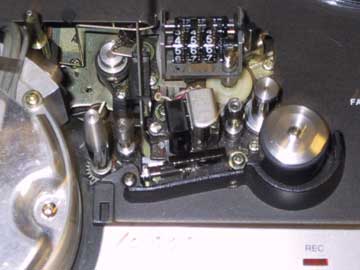In the world of 1/2"open reel transfer, most tapes are EIAJ. However, you may encounter "skip field" or CV tapes. The formats are not compatible; a CV tape will not play back properly on an EIAJ- compatible machine. On an EIAJ-compatible deck, a "skip field" tape will play back sound correctly but video will be skewed and out of sync. While the video is present, it is out of sync. If you encounter a tape which has good audio but noisy video, then the heads on the playback deck are probably dirty.
You may encounter a tape with EIAJ recorded on one part and "skip field" recorded on the rest.
Tape players/recorders are electromechanical devices. They function by mechanically pulling a magnetic tape over magnetic heads.

There are separate heads for audio recording, audio playback, video recording, and video playback. There are also playback and recording heads for other signals such as control track pulses. The electronics of the tape player/recorder process signals as they pass between the tape and the input/output connectors of the player/recorder.
One of BAVC's source decks is the Sony CV-2100, a 1/2" open reel videotape player. The CV-2100 plays videotapes that are recorded with "skip-field" equipment.
The NTSC signal, the standard for video signal recording in the U.S., is made up of 30 video frames per second, each frame is constructed of 2 fields of video. There are 60 fields per second in an NTSC video signal.
Tapes recorded on "skip field" equipment have only 30 fields per second (one field per frame). A second field is interpolated by the video player's electronics. The signal will therefore play back properly on an NTSC monitor, or be sent properly to an NTSC video recorder for transfer. Video recorded on "skip-field" equipment is monochrome.
A CV-2100 offers special challenges, there is no BNC or RCA connectors for video output. What to do?
There is an 8-pin EIAJ connector on the CV-2100. This connector effectively "bundles" both input and output signals for video and audio as well as ground into a single cable. In the early 1990s, many studio monitors and video recorders still used this type of connector in the early 1990's to reduce the tangle of cables in a studio.

To send the video signal out of the CV-2100, I ordered an 8-pin EIAJ connector from Comprehensive Video in San Francisco. I cut off one BNC end of a short BNC cable and soldered the cable's conductor to pin 2 of the EIAJ connector, and the cable's metal sheathing (layer just beneath outer plastic coat) to pin 6 for a ground.
I keep this 8-pin EIAJ to BNC cable short so it is portable and functions like an adapter. A barrel connector and a longer BNC cable complete the video connection.
The audio connector on the CV-2100 is a mini plug and the signal is not +4 db. If the record machine has +4 db audio (Beta SP, Digital Beta, one inch, etc), the audio will need to be matched.
I've also had problems with video signal termination coming directly off of the CV-2100. Termination means to complete a circuit by connecting a resistive load to it. A video termination is typically a male BNC connector which contains a 75 ohm resistive load. When there are looping inputs, any unused looping input must be terminated in 75 ohms to ensure proper signal levels and to minimize reflections.
An example is a video with a close up of a human face. Directly off the CV-2100 I could distinguish few facial features. To address this, I did an experiment. I transferred the skip-field signal directly onto a 3/4" U-matic tape. On the Sony VO-9850 U-matic recorder I used, a, the video input level can be adjusted. I turned this all the way down. I then transferred from the U-matic through a time base corrector (the Sony BVT-810), again lowering the video signal.
The results astounded me. I could make out freckles and hair strands. The face was very clear and detailed.